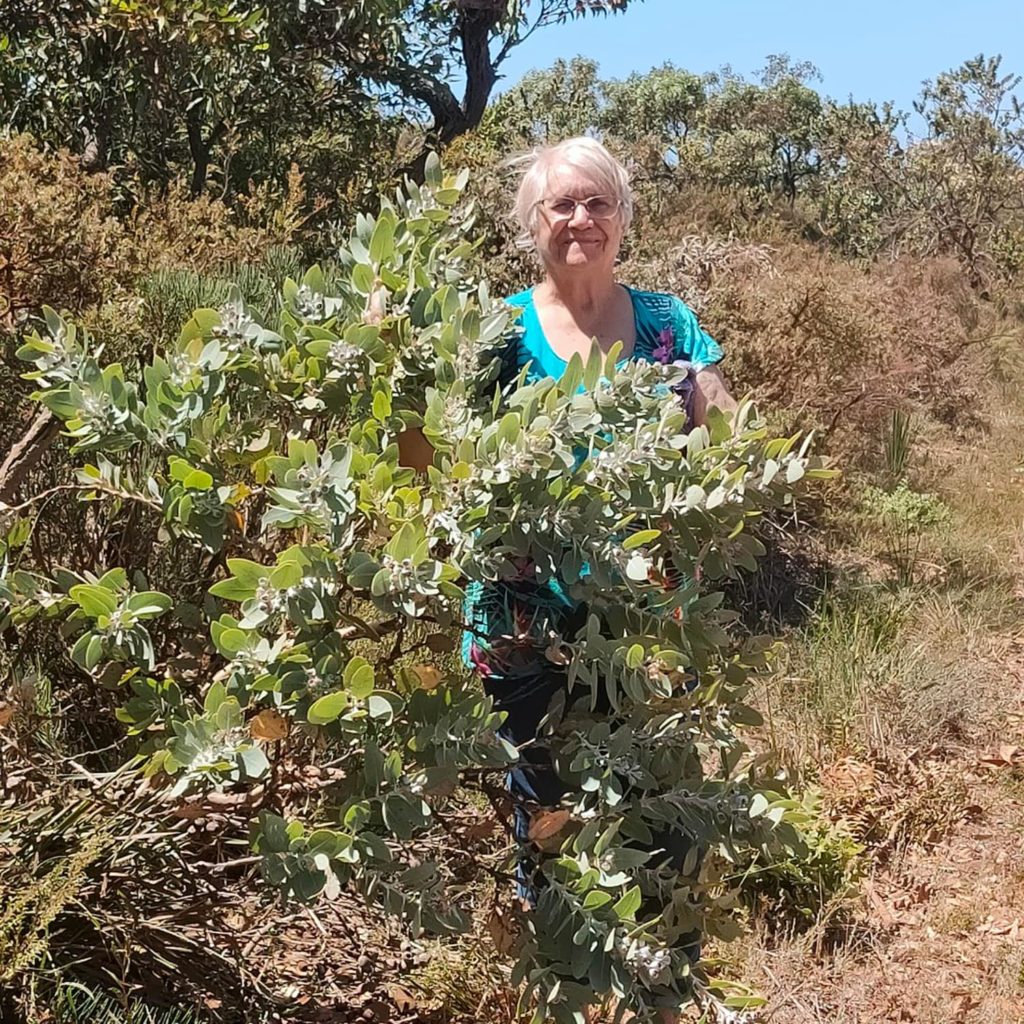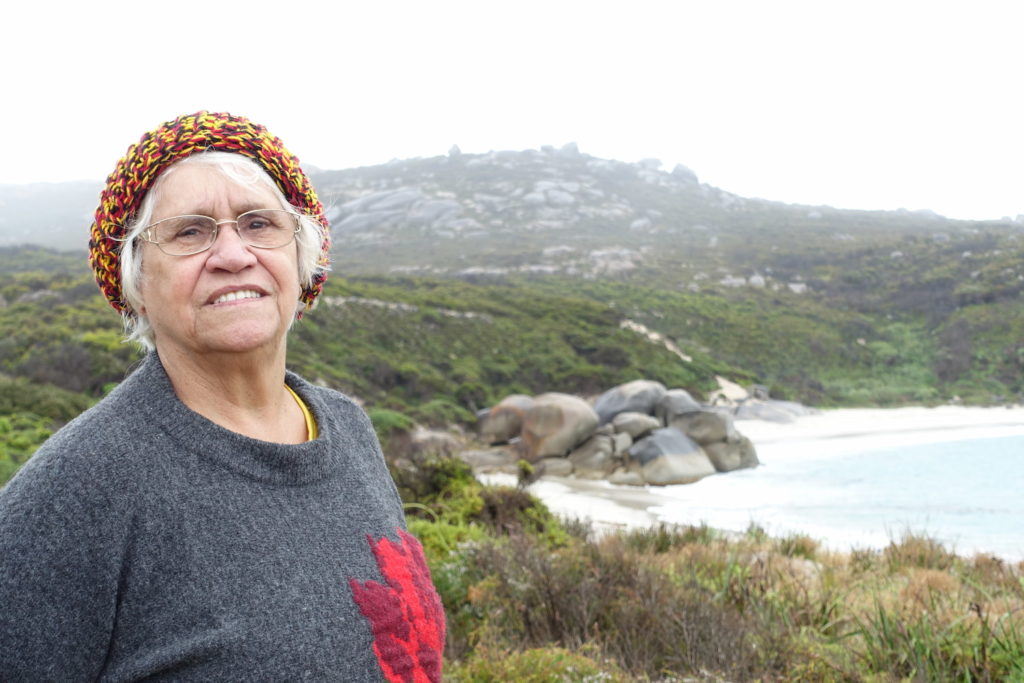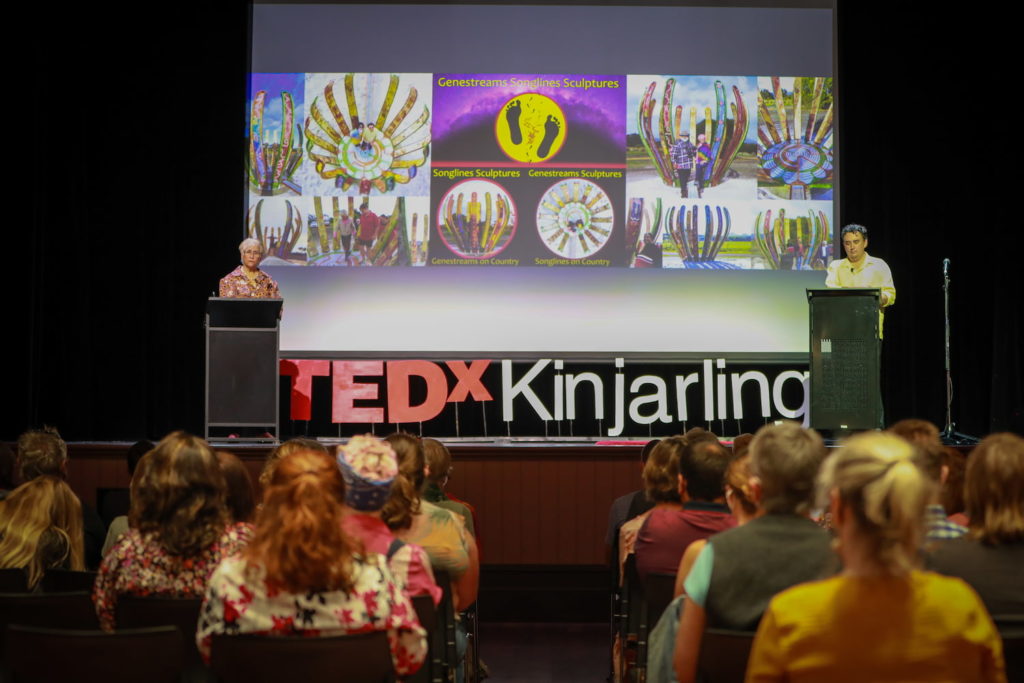Aunty Carol Pettersen shares her connection to Boodja
Carol Pettersen OAM JP is a Menang-Gnudju Elder. Aunty Carol (nee Gray) was born at Gnowangerup Mission Hospital in 1941 and then raised in the bush around Jerramungup with her family. She has spent much of her life in the Albany area, on her maternal Grandfather’s traditional Menang country. Her maternal Grandmother was from Gnudju country around Norseman.
Aunty Carol has long been involved in Indigenous Affairs at a Federal, State and local level, including 35 years as a Justice of the Peace. In 2008 she was awarded National NAIDOC Female Elder of the Year and in 2022 she was awarded a Medal of the Order of Australia (OAM).

In this story in Gondwana Link’s “Heartland Journeys” series, Aunty Carol shares a compelling story of her connection to Boodja, or country.
“The essential thing is the land, the Boodja, because on the Boodja we’ve got our Storylines and they tell us about the creation of the landscape ‒ we’ve got the hills, the rivers, we’ve got the flora, the fauna. We teach our younger ones about our totemic system, which is grounded in our Boodja and is our religious belief,” Aunty Carol says.
“When an Elder passes on knowledge, that’s what happened because it’s been handed down hundreds and hundreds and hundreds of years. I’m still a living memory of at least 200 years. So there’s me, my mother, my grandfather, and his mother. That’s four generations of living memory, and we’re still handing these stories on, so there’s my children and great grandchildren. So there’s, you know, six, seven generations of living memories and living narrative of these stories.”
For much of last century, an ever-present danger for Noongar children was being forcibly removed from their families by the Government’s Native Welfare Department, often with police assistance, and placed in a mission. The generations of children removed under these policies became known as the Stolen Generations. When Aunty Carol and her siblings were children, the bush was a safe place to hide.
“It wasn’t about being scared of living in the bush or bushfires or any natural disasters, we were actually scared of the Police; we were surviving and hiding from the Native Welfare Department as well”, Aunty Carol says.
“We learnt how to live with the bush. Mum and Dad were shepherds, along with Grandfather, so us children learnt to live all day long on our own. We knew how to prepare the fire because we had to prepare our own food ‒ but we had to catch it first. We were taught never to come back to camp empty handed; we had to come back with something to supplement camp supplies. And food was so bountiful out there, it was like a supermarket, you know.
So, yes, the bush was a haven and a sanctuary, yep, absolutely. It was one of the most glorious times of my life. And of course that all changed when we went to the mission and were exposed to the cruelties of ‘christianity’, as they called it at that time. One of the worst things was the missionaries didn’t allow me to hug my older brother because he was darker skinned than me – us mission kids were segregated by our skin colour.”
Aunty Carol describes life in the bush in those early years as being guided by nature the whole way.
“We’d know the weather by the moon at night ‒ Mother would be able to tell us what sort of a day it was going to be tomorrow, and that determined our movements. The weather was the first superior ‘being’. And then the flora ‒ we were taught to look at how flora responded to the weather. When it was spring, when it was winter, when it was summer, when it was going to rain ‒ all those different signs of the flora guided us,” Aunty Carol says.
“The next guiding sign was the birds as they fed off the flora. And, of course, the animals, especially kangaroos, moved with the abundance of flora, or whether the water holes had filled up from the recent rains.
“But complementary to that, we had a well-rehearsed route of travel ‒ our people knew where the water holes were as well. And the thing is, in watching the smaller birds, you’d know whether the water was still fresh. If the birds weren’t going there, we knew we’d have to clean it out. So we were actually guided by nature the whole way.
“And so it’s that connection to Boodja that’s conditioned from birth – because mothers knew where they wanted their babies to be born to imbue them with the spirituality of that actual spot. Then as we grew up, Mother would say “That’s your spot, that’s your place”, and only now, through my involvement in this landcare movement, I understand her words meant that it is my place and it’s my responsibility to take care of it. And so I in turn tell my grandchildren about it ‒ “That special place, that’s your place”. And that’s where the sense of identity and sense of belonging comes from ‒ you’re born into it.
“We never knew anything about fixing things because there was nothing broken. If it was ‘broken’, then nature, and the spirits that nature left in charge, deemed that it was their responsibility. So, for instance, if a tree fell down across our pathway, we wouldn’t attempt to move that tree, we would walk around it or walk over it and then in 12-months-time we’d see the little suckers growing out of the tree. So nature knew there was still some energy in that tree to be able to regenerate more trees.
“It took me a while to work out what is this ‘land restoration’ because the land was okay as far as we were concerned. The hills were there, the rivers – you just had to keep everything clean and work with nature. Move when nature determined. We’d move and allow that re-growth of the flora. When the fauna moved, we moved with it, because then there was little impact on one particular spot.
“Noongar tribal boundaries are determined by our connection to flora and our family has the connection with the Talyeraak tree (see image below) . Wherever there are Talyeraak, we know we’re safe in ‘country’. And even now, I feel a little bit out of place when I leave our Talyeraak country behind. And even my grandchildren, one little girl said to me, “Nan, I can’t see our Talyeraak tree”. So that’s how the kids learn this recital that’s handed down over the years”.

“My ‘country’ does not go past the Stirling Ranges. The Stirling Ranges is a neutral territory. No tribe owns the Stirling Ranges. And so we’re sort of just south of that. We could see it, but always from in Talyeraak country that hugs the coast. Our clan group were recorded as being called the Shell People ‒ even though we’re part of the Gnudju-Menang, we’re still known as the Shell People.
“Noongar way, we had our estates, and we had our land holdings. But there were no fences. There were tribal boundaries in that you had to ask permission to go there. And even today, when our Noongar menfolk from other regions come to Albany, they still ask permission to go fishing, because that’s cultural protocols. They ask permission from our Noongar men down here, “Can I go fishing?” And of course, the answer is “Yes”, because you’ve shown respect. Even today, we still need permission to travel through other tribal lands.”
There is increasing understanding by non-Aboriginal people of the ways in which Noongar people shaped their environment in sustainable ways. Aunty Carol describes the totemic system, which is a way of sharing the responsibility of caring for different parts of the natural world.
“We did have a sense of agriculture in that we dug for yams and we aerated the soil and created little gutters for water catchments so the plants were able to grow again. The thing is, we never pillaged the land. We just took what we needed,” Aunty Carol says.
“Our whole cultural activity was about ‘caring for country’; it was about cultural maintenance. And by thousands of years of practice of letting nature take control of the landscape, we didn’t have to fix anything.
“The thing that comes to my mind is shared responsibility. With Noongar people we have the totemic system, where we are only responsible for one fauna and one flora. And thinking about my own, we have a little bird, the Western Spinebill, that we believe to be the spirit of our Grandmothers from ancient times. And that little bird would show us where kangaroos were, for hunting, and it would tell us where to find the wild honey tree. Mother would put either a piece of fresh meat or a honeycomb on a tree as an acknowledgment of the reverence of the relationship.
“And so other people had their totems as well ‒ some had turtles, others had emus, or some other animal, and they were only responsible for that one. But in a holistic sense, everybody had that shared responsibility of looking after the land, looking after their totem and looking after the connection of that totem to the landscape.”

During her life Aunty Carol witnessed major changes to the Boodja, with the broadscale clearing of the country which started in the 1950s.
“Not only was the bush being cleared, but it was our sites that were being damaged. And then also the access to those sites that was being denied through the clearing because the fencing then came in and private property took over,” Aunty Carol says.
“You know, we were sad that the fences cut off our traditional routes and our waterholes and all of that. But we knew the stories were still there. We were angry because suddenly our waterholes were becoming salty, our swamps were becoming salty and we could see the country suffering and dying. But in order to survive we had to adapt to these changes and work with the farmers, which kept us connected to Boodja.
“Noongar people were the backbone of development of this country, through the contract work of root picking and other farm development work. I can remember dam sinking, you know, using one horse with an old plough and having to get up to your knees in muck and fix the plough up, and things like that. So Noongar people back then were the backbone of the development of this country and I feel the history books don’t fully appreciate our efforts. However, today we as a society do acknowledge the contributions of other nationalities during that time, like the Italian migrants who were also out there root-picking.”

Aunty Carol talks about bringing life back to ‘country’, particularly out at Nowanup, a property in the Gondwana Link near Boxwood Hill. The Noongar program at Nowanup, led by Elder Eugene Eades, has become central to a range of camps and courses focused on healing country and healing people.
“I had no knowledge of how to fix the land because all I could see in front of me was continual ploughing and burning and fencing and whatnot,” Aunty Carol says.
“And then when the Nowanup project came along and Eugene asked me to come out, that was an incredible feeling. You can look at some photos that were taken around 2005 that show just the bare landscape of paddock and pasture. To see what it looks like now, it’s just incredible to see what happened in such a short time. Everything came to life, soon as you planted the trees and bushes, you could feel the land coming to life. You could hear the birds singing and the kangaroos were no longer timid because they were in their environment.
“I fully embrace what’s happening there. I took my great grandchildren out and we worked with a large group to plant 5000 trees and bushes in one afternoon. A few years later I took them back out and they felt like they owned the plants because their seedlings were now young trees. But the greatest reward was seeing the return of the Malleefowls. They came back and they trusted us enough to start building their nest. It was wonderful, a wonderful connection to country ‒ to Boodja.”
Thanks to Frank Rijavec for the original recording of Aunty Carol; Nicole Hodgson for story development and Marg Robertson for story editing with Aunty Carol.
